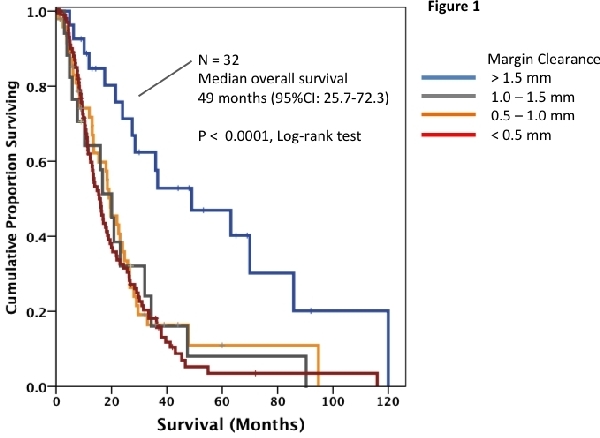|
Back to Annual Meeting Program
The Prognostic Influence of Resection Margin Clearance Following Pancreaticoduodenectomy for Pancreatic Ductal Adenocarcinoma
Nigel B. Jamieson*, Nigel Chan, Euan J. Dickson, Colin Mckay, Ross Carter
West of Scotland Pancreatic Unit, Glasgow University Department of Surgery, Glasgow Royal Infirmary, Glasgow, United Kingdom
Introduction:
The poor overall survival associated with pancreatic ductal adenocarcinoma (PDAC) despite complete resection suggests that occult metastatic disease is present in most at the time of surgery. Resection margin involvement (R1) following resection is an established poor prognostic factor. However the definition of an R1 resection varies and the impact of margin clearance on outcome has not been examined in detail.
Methods:
In a cohort of 215 consecutive patients who underwent pancreaticoduodenectomy for PDAC with curative intent at a single institution between 1996-2010, the prognostic significance of the proximity of margin clearance was investigated. Microscopic margin clearance was stratified by 0.5 mm increments from tumor present to greater that 2 mm. Groups were dichotomized into clear and involved groups according to the different R1 definitions. Multivariate survival analysis was used to establish independent prognostic factors. Clearance of individual margins was also considered.
Results:
Stratification of the minimal clearance distance revealed that there was no significant difference in the outcome of patients with tumor ≤ 1 mm from the margin when compared to those with tumor ≤ 0.5 mm from the margin (P = 0.67, Log-rank test). For the 32 patients (15%) where the tumor was > 1.5 mm from the closest involved margin there was a significantly prolonged overall survival (median 49.0 months 95% confidence interval: 25.7 - 72.3, P < 0.0001, Log-rank test, Figure 1). This cut-off represented the optimum distance for predicting long-term survival.
Conclusion:
These results demonstrate that margin clearance by at least 1.5 mm identifies a subgroup of patients with a particularly good outcome. Stratification of patients into future clinical trials based upon the degree of margin clearance may identify those patients likely to benefit from adjuvant therapy.

Kaplan Meier survival curves illustrating that a cut-off of greater than 1.5 mm identifies a subgroup of patents (15%) with pancreatic ductal adenocarcinoma with a good prognostic outcome following resection by pancreaticoduodenectomy.
Back to Annual Meeting Program
|


